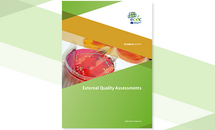Eleventh external quality assessment scheme for Salmonella typing
This report presents the results of the 11th round of the external quality assessment (EQA-11) scheme for typing of Salmonella enterica subsp. enterica organised for the national public health national reference laboratories (NPHRLs) in ECDC’s Food- and Waterborne Diseases and Zoonoses network (FWD-Net) managed by the European Centre for Disease Prevention and Control (ECDC). The EQA-11 scheme was arranged by the Section for Foodborne Infections at the Statens Serum Institut (SSI) in Denmark.
Executive summary
Salmonellosis was the second-most commonly reported zoonotic disease in the European Union (EU) in 2019, with a notification rate of 20.0 cases per 100 000 population. The total number of reported cases was 90 105 [3]. Since 2007, ECDC has been responsible for EU-wide surveillance of salmonellosis, including facilitating the detection and investigation of food-borne outbreaks. Surveillance data, including certain basic typing parameters, are reported by Member States to the European Surveillance System (TESSy). Since 2012, the EQA scheme has covered molecular typing methods used for EU-wide surveillance.
The effective molecular typing-enhanced surveillance relies on the capacity of NPHRLs in the FWD-Net to produce comparable typing results. ECDC has opened the possibility for Member States to submit WGS data for Salmonella and Listeria monocytogenes to TESSy to be used for EU-wide surveillance and cross-sector comparison. The previous EQA schemes from EQA-4 to EQA-8 included assessment of the PFGE typing methods for all Salmonella serovars and MLVA for S. Typhimurium (STm). Since EQA-8, the participants could participate in MLVA for S. Enteritidis (SE). From EQA-9, the separate PFGE part was excluded. Since then, PFGE has only been included into the cluster analyses part where the ability of identifying a cluster based on molecular typing by either using PFGE, MLVA and/or whole genome sequencing (WGS) derived data was assessed.
The objectives of the EQA-11 scheme were to assess the quality of data and comparability of molecular typing analysis results produced by NPHRLs in FWD-Net. Test isolates for the EQA were selected to cover isolates currently relevant for public health in Europe. Three sets of 10 isolates were selected, including S. Typhimurium and S. Enteritidis isolates for the respective MLVA methods and the cluster analysis included ten S. Enteritidis ST11 isolates.
Twenty-one laboratories signed up and 20 completed the exercise. This is a decrease from EQA-8 (N=23) by 13%. It is unknown if the removal of the PFGE part (gel quality and analysis) was the cause of this. Most laboratories (N=19) participated in the molecular typing-based cluster analysis. Out of the 20 laboratories participating in EQA-11, 14 (70%) performed molecular typing-based cluster analysis using WGS-derived data, which is one less compared to EQA-10.
In total, eight laboratories participated in the S. Typhimurium and S. Enteritidis MLVA analysis, which is slightly fewer compared with EQA-8, when 10 and eight laboratories participated, respectively. The performance level was high for both analyses (95% and 98% respectively) and within the range of the previous years.
The aim of the cluster analysis part of the EQA was to assess the NPHRL’s ability to identify a cluster of genetically closely related isolates i.e. correctly categorise cluster test isolates regardless of the method used. The cluster of closely related S. Enteritidis ST11 isolates could be investigated by PFGE, MLVA and WGS-derived data. The expected cluster was based on a predefined categorisation by the organiser and contained five isolates based on WGS-derived data.
The number of laboratories performing WGS has stabilised as no new laboratories performed WGS this year and over time, the use of PFGE and MLVA has become less frequent. Fewer laboratories performed cluster analysis with more than one method and only one laboratory performed cluster analysis using all three methods in EQA-11.
Six laboratories used PFGE for cluster analysis and for three participants; PFGE was the only cluster analysis method. None of the six laboratories were able to identify the correct cluster using PFGE. Four laboratories used MLVA for cluster analysis and two laboratories only used MLVA for the cluster analysis. All ten test isolates had the same MLVA profile and therefore it was not possible for the participants to identify the correct cluster of closely related isolates using this less discriminatory method.
The performance among the 14 participants using WGS derived data was very high, as 13 (93%) correctly identified the cluster of closely related isolates and the use of allele-based analysing method (mainly core genome multilocus sequence typing (cgMLST)/Enterobase scheme) was dominant.
An assessment of six EQA provided genomes was an additional part to the molecular typing-based cluster analysis. In an urgent outbreak situation, the sequence data available is not always of high quality, therefore, this EQA-part was designed to mimic this situation. The participants were asked to assess six genomes, which were modified by the EQA provider in order to give a realistic view of different quality issues. All participants (except one for one of the genomes) successfully identified the three genomes of high quality as either a cluster isolate (one genome) or a non-cluster isolate (two genomes). Two poor quality genomes with contamination of a different Salmonella ST34 (20%) were identified by all the participants. Ten of 14 participants identified the genome with 10% Citrobacter -contamination.
Download







